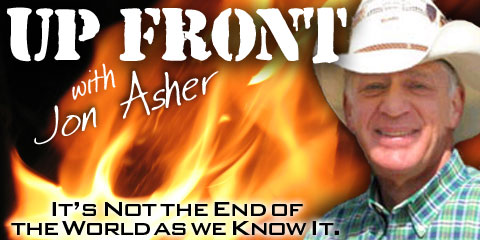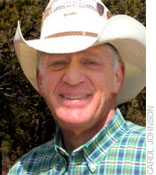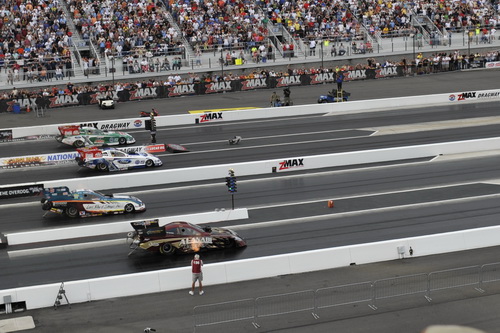UP FRONT: IT’S NOT THE END OF THE WORLD AS WE KNOW IT
Mon, 2010-02-01 20:54
 Whether or not we’ll admit it, we live in a world of transition, and that certainly includes our little niche of drag racing. But, to see and read the vitriol, angst and woe-is-me rants that are flying around the Internet you would think that everything we know and cherish is about to come to an end, all because of the mutual announcement from NHRA and zMax Dragway that their March race will feature qualifying and eliminations racing in all four lanes of the showplace facility.
Whether or not we’ll admit it, we live in a world of transition, and that certainly includes our little niche of drag racing. But, to see and read the vitriol, angst and woe-is-me rants that are flying around the Internet you would think that everything we know and cherish is about to come to an end, all because of the mutual announcement from NHRA and zMax Dragway that their March race will feature qualifying and eliminations racing in all four lanes of the showplace facility.Regardless of what happens in North Carolina on Sunday, March 28th, drag racing will survive, and for all we know now, the concept of four-lane racing might actually help the sport grow.
We need to consider a little history before we start collectively slitting our wrists, because if you think this is the first time some have suggested drag racing was headed into the abyss, you’re sadly mistaken.

Regardless of what happens in North Carolina on Sunday, March 28th, drag racing will survive, and for all we know now, the concept of four-lane racing might actually help the sport grow.
We need to consider a little history before we start collectively slitting our wrists, because if you think this is the first time some have suggested drag racing was headed into the abyss, you’re sadly mistaken.
After Mike Sorokin lost his life to a clutch explosion, lightweight, paper-thin aluminum clutch cans were outlawed and steel versions became mandatory. No less a legend than “Big Daddy” Don Garlits bemoaned the fact that his car would now “weigh too much” to be fast. When it was pointed out to him that everyone’s car would weigh the same because everyone would have to have the same heavy clutch can, he calmed down – and drag racing didn’t go under when everyone’s car picked up that additional 100 or so pounds.
When Winston became NHRA’s series sponsor and a season-long points system was introduced, ending the tradition of crowning a World Champion for having won a single race, diehards cried long and hard that it would be the ruination of the sport. What actually happened was that drag racing got better because both fans and media could follow what was happening to their favorites from the Winternationals through the Finals.
More recently the NHRA had the audacity to introduce the Countdown program, ending an almost 30-year tradition of season-long points chasing, and diehards swore they’d never attend another event. Petitions were circulated, threats were made, letters written. Drag racing did not end as we know it. In fact, while there have been some problems with the Countdown program (and we anticipate more this year with the Countdown to 10 ending in the media black hole of Brainerd, Minnesota), there’s little doubt that the concept itself has largely worked. Instead of champions being crowned two, three or even four races before the end of the season, we’ve had battles being fought all the way into the deepest rounds of the Finals at Pomona. They’ve been the kind of battles that draw media and fan attention, which has been good for the sport. Remember, it was the pressure of making the Countdown that produced the unforgettable confrontation between Tony P. and Mr. Force at last year’s U.S. Nationals. If that wasn’t great theater, I don’t know what is – and the Countdown was responsible for it.
There have certainly been some instances of changes not working. The Winston race at Bristol in which Funny Cars raced dragsters comes to mind. Even before that event took place there were those who deemed it a travesty, but it didn’t turn out that way. Yes, there were unforeseen problems and yes, the show wasn’t quite as good as many had hoped – but it didn’t kill drag racing. The NHRA learned from the experiment, and while it hasn’t yet been repeated, who knows, at some point it might be tried again – and if it is it still won’t kill drag racing.
a d v e r t i s e m e n t
Click to visit our sponsor's website
 There have been other instances of failures and mistakes while trying to bring about meaningful change to drag racing. Those of us old enough can recall when NHRA was literally too arrogant to recognize drag racing reality, and temporarily banned nitromethane fuel. That fiasco was followed by their failure to recognize the popularity of Funny Cars, relegating them to Competition eliminator. And despite their claim of having “legitimized” Pro Stock, historians know that AHRA’s wildly popular heads-up Super Stock, with the likes of Dickie Harrell, Dyno Don Nicholson, Dandy Dick Landy, Sox & Martin and many others literally forced NHRA into adopting the class. Even then NHRA was the largest and most proficiently run sanctioning organization, and even though they made the errors outlined, drag racing didn’t die, it continued to thrive and grow.
There have been other instances of failures and mistakes while trying to bring about meaningful change to drag racing. Those of us old enough can recall when NHRA was literally too arrogant to recognize drag racing reality, and temporarily banned nitromethane fuel. That fiasco was followed by their failure to recognize the popularity of Funny Cars, relegating them to Competition eliminator. And despite their claim of having “legitimized” Pro Stock, historians know that AHRA’s wildly popular heads-up Super Stock, with the likes of Dickie Harrell, Dyno Don Nicholson, Dandy Dick Landy, Sox & Martin and many others literally forced NHRA into adopting the class. Even then NHRA was the largest and most proficiently run sanctioning organization, and even though they made the errors outlined, drag racing didn’t die, it continued to thrive and grow.More recently drag racing’s traditional quarter mile length was chopped to 1,000 feet for safety reasons, arousing a storm of protest that made the whining about the Countdown seem like nothing more than an over-sugared 6-year old during a showing of Alvin & The Chipmunks. I remember the cascade of boos that rolled down out of the grandstands in Denver when the first 1,000 foot run was made – but I also remember that by the time the first session ended most of the fans had accepted it and, like it or not, they were willing to live with it because even though the racing surface was 320 feet shorter than it had been, it was still drag racing. It was still loud, it still aroused the senses with spent nitro fumes and racing’s superstars, from Force to Dixon and Schumacher to Capps, were the same charismatic figures they’d been two weeks earlier. We may not like 1,000 foot drag racing, but it’s still an acceleration contest from a standing start that produces 300 mile per hour speeds – and it’s certainly better than no drag racing at all.
Just so you completely understand my personal attitude, I intensely dislike 1,000 foot racing because – and here I go talking about tradition when earlier I indicated it wasn’t the most important aspect of our little world – drag racing has more than 50 years of quarter mile racing. But a funny thing happened on my way to Protest Park. I started listening to all the objections to 1,000 foot racing and realized that 99% of them were coming from people who aren’t currently driving Top Fuel dragsters or Funny Cars. It’s far too easy for us to decry 1,000 foot racing just because we’re not driving those cars. We’re not the ones risking our lives. It’s kind of like the cowboy I met at a rodeo last summer who loudly proclaimed that today’s rough stock and bull riders were sissies because many of them choose to wear helmets and all of them wear protective ballistic vests. He didn’t want to hear about how it made the competitors safer, but he did shut up when I asked him if he was willing to climb on a 1,500 lb. bull with just jeans, chaps, a shirt and hat on, particularly when safety gear was available. Naturally, he wanted no part of actually riding himself, but it was certainly easy for him to complain about the way others were risking their lives. In many respects those who complain about 1,000 foot drag racing are doing the same thing – complaining from the safety of their computer keyboards or grandstand seats without taking any personal risk.
I continue to believe that returning to full quarter mile racing is important to the sport, and I sincerely hope that those involved in trying to find a solution to slowing the cars to manageable speeds can set their egos aside and figure things out. But, until that happens – and even if it never happens – drag racing is going to continue to be a viscerally exciting and emotionally satisfying endeavor. Even if circumstances some day result in the fuel cars running just an eighth mile at a time, it will still be drag racing, and we’ll somehow adjust to that new reality.
It may be that come sundown on March 28th NHRA and zMax Dragway officials will be heaving a sigh of relief, knowing they dodged a bullet for just having completed the race. Maybe they’ll recognize that this was an idea whose time hadn’t come. Of maybe they’ll be collectively smiling from ear to ear as hundreds – maybe thousands -- of fans go out of their way to tell them what a kick-ass deal it was to see four Top Fuel cars blasting down the track side-by-side at one time through three rounds of eliminations.
So, in the meantime it’s time to take a chill pill and calm down. It’s time to stop screaming that the sky is falling, because it isn’t. It’s time to finalize travel plans for the 50th Annual Winternationals. It’s time to think about Phoenix and Gainesville and yes, even the race at zMax at the end of March. Let’s see for ourselves if this is a good or horrendous idea, because as of right now, as January comes to a close, no one, from Tom Compton and Bruton Smith to Bruce Corneto and Joe Sherwood, truly knows if four-wide racing will work or not. Let’s hold the whining until March 29th. As of that date feel free to fire away, because at least then you’ll be complaining from a somewhat factual standpoint. Right now you’re just shouting into the wind – and no one can hear you.
| {loadposition feedback} |
Categories:





































